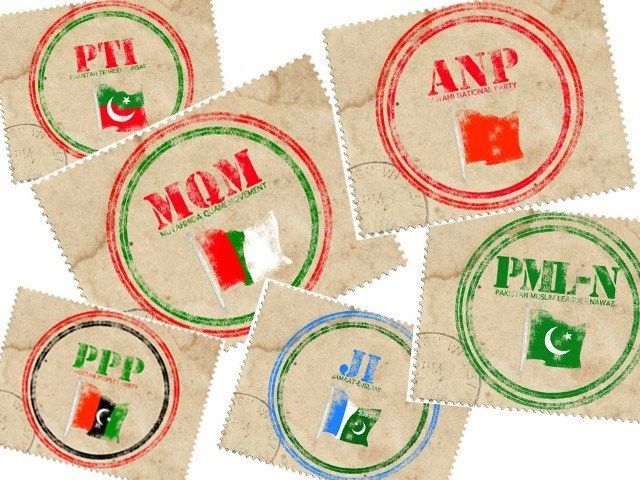
Political parties have developed to reflect and accommodate various fissures in broader Pakistani society

As general elections 2018 approach, political parties have asked contenders to apply for party nominations.
Before the Election Act 2017, the law defining electoral procedures and political parties, the number of registered political parties in the country was 284.
According to the new law, every political party is required to submit with Election Commission of Pakistan (ECP) a list of at least 2,000 members with their signatures or thumb impressions along with copies of their national identity cards and Rs200,000 as enlistment fee.
In early this year, the new law brought the number of political parties to mere 30. Till date, the number of political parties, registered under the new procedure has gone up to 119. However, only 103 of them are going to contest the elections and allotted party symbol.
A look at the parties listed with the ECP shows that out of 103 parties participating in general elections 2018, less than 10 are mainstream parties at the national or federal level; nearly a dozen are regional parties, mostly active in a particular province.
A majority of the registered political parties are small having religious, ethnic, regional and linguistic identity. A large number of small and big registered political parties are led by its main/founding leader without any regular and proper district and local level tiers.
According to definition, a political party is "an association of citizens or a combination or group of such associations formed with a view to propagating or influencing political opinion and participating in elections for any elective public office or for membership of a legislative body, including an Assembly, the Senate, or local."
The Election Act 2017 reads that "a political party shall formulate its constitution, by whatever name called, which shall include the aims and objectives, organisational structure of all tiers, record of membership fee and other structural and internal democracy details. Political parties in Pakistan lack internal democracy and a participatory approach.
One way of locating the centre of gravity in a party organisation is to analyse the way the leadership seeks to keep the powerful elements on board and refrains from alienating them as far as possible.
A combined study by The Asia Foundation and Lahore University of Management Sciences found "a gross institutional imbalance" in favour of the postcolonial state apparatuses of bureaucracy and army against political parties and parliament from independence onwards.
The study conducted in 2012, reads that "Pakistan has seen the evolution of a one-party dominance model, initially through the various incarnations of the Pakistan Muslim League (PML) and subsequently through the dominance of the Pakistan People’s Party (PPP). Only in 1988 did this basic structure shift to a two-party dominance model, with power shifting between these two major parties, albeit interrupted by the intervention of the military. This history has led to a political landscape in which parties have come to represent the various fragmented interests within Pakistan, rather than distinct policy positions."
The study further points out that parties have developed to reflect and accommodate the various fissures in broader Pakistani society: religion; sectarianism; ethnic and nationalist interests; and linguistic differences. Parties in contemporary Pakistan reflect these factors of "identity politics".
The document indicates that parties are typically inactive during the period between two elections. As patronage structures, they do constituency work and get things done for their supporters. But they remain dormant in terms of organisational work. They indulge in a high level of activity only before and during the elections.
"Political parties are made of three things -- leader, electable(s), and ideologues. This was seen in PPP in Zulfikar Ali Bhutto era and now to some extent in Pakistan Tehreek-e-Insaf, which is having these three elements now," says Dr Muhammad Waseem, political scientist, who was also instrumental in conducting The Asia Foundation-LUMS study. He believes Pakistan’s political parties are still leader-oriented.
Read also: Success guaranteed
"Political parties in Pakistan are organisationally weak. There is absolutely no improvement since years. They are moving in circles," he says, adding, "Political parties are not policy and issue-oriented. Therefore, they go for leadership in lieu of policy and ideology. There is no relevance of policy in political parties in Pakistan. A large number of middle-class, which matters, stays away."
"In the electoral system and structure of political parties citizens do matter only for balloting. And rather than individual voting trend, we see communal voting trend. There is trend of going to people to get vote. Rulers are constrained to go to people after a certain period but this is only electoral democracy following procedural concept," he explains. "We are still fare away from participatory and substantive democracy through political parties."